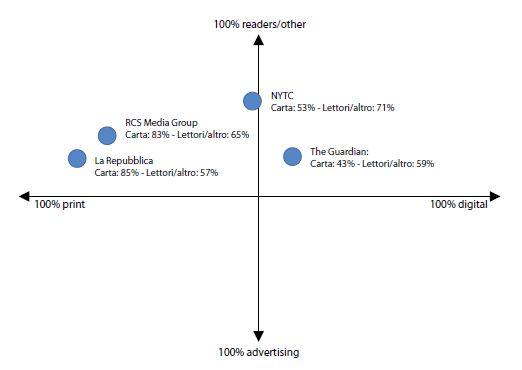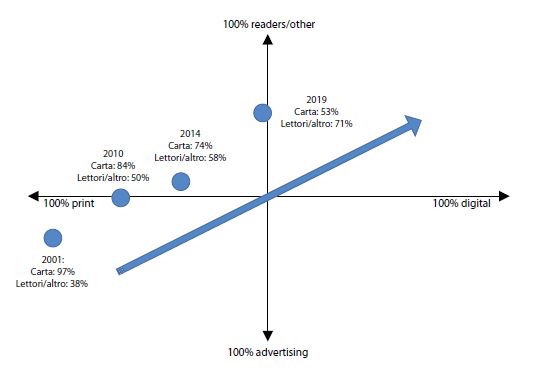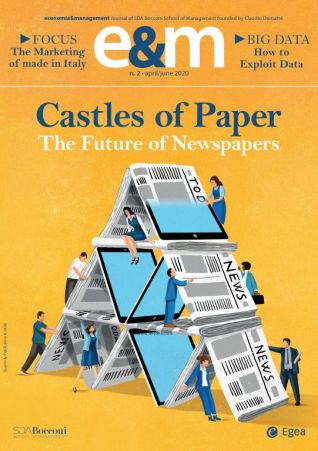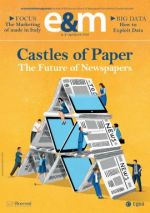E&M
2020/2
A Predictable Decline and the Strategy of Newspapers
In the 1990s and the beginning of the 2000s, the majority of publishers and daily newspapers adopted the same business model as commercial television: published content became available to everyone for free and it was decided that digital revenues would only come from advertising sales. Furthermore, apart from some international leaders, the relationship between the exploitation of print media and the exploration of digital was managed with difficulty by almost all publishers. Among the possible future developments in the sector, there is the possibility to reposition newspaper products in a higher segment, abandoning the “popularization” launched during the 1990s, and developing a commercial logic that takes into account the rebalancing between the market of readers and the advertising market.
The crisis of newspapers has generated a broad debate in the world of journalism[1] and academics[2] that revolves around the following questions: will newspapers survive? If so, in what form? If not, what will the consequences be for the sector and for democratic systems?[3]
To respond to these questions it is necessary to go back to the middle of the 1990s, when daily newspapers decided to diversify and to add digital content alongside traditional print copies.[4] There were three ways for newspapers to approach internet: deciding to resist against the web and remain off-line, and thus not publish their contents digitally; or deciding to embrace the new technology and publish their content on-line for free, or publish it for payment. In all three cases they also could have put pressure on public authorities to regulate the spread of informational content through the internet.[5]
The “original sin” of publishers
The first movers and market leaders (for example The New York Times in the United States and la Repubblica in Italy) immediately decided to embrace the new technology, and with this embrace they imitated the business model of commercial television, that is, to diversify by publishing their content for free, basing digital revenues only on advertising sales. They also failed to exercise pressure in favor of the regulation of internet in some manner. This move contributed to making free access the standard in the sector, establishing constraints for other newspapers and followers (only a few newspapers deviated from this strategy, such as The Wall Street Journal). The decision was made in order to finally challenge television on the same ground, that of the immediacy of information and advertising sales.[6] At this point, newspapers could have bet on the differentiation of their product, with respect to both television and what is offered by all the other actors who began to emerge and spread on internet, and define themselves as pure digital publishers. The goal of traditional newspapers was to use internet to expand their potential market, adding the readers/consumers of the digital addition to the readers/buyers of the print version, and adding advertising investors in the digital edition to those of the print version. The digital product was thus intended as complementary to the print edition. However, in essence they did not only imitate the business model of commercial television, but also the content and form, reducing the differentiation of their products with respect to those of television and the other actors present on internet.
The crisis before internet
This strategy of imitation, though, did not depend only on the diversification required by internet, but on a process that had begun beforehand, and developed simultaneously. This situation was observed in our country in particular.
In Italy, unlike in other countries, newspapers never reached mass penetration, and a clear distinction was never reached between “quality newspapers” and “popular newspapers.”[7] Moreover, after the peak of copies sold was reached in 1990,[8] there was a gradual decline (that then turned into a rapid collapse).[9] To respond to this situation, the newspapers decided to position themselves more towards the “popular” dimension, an approach that influenced both content and graphic style.[10] As regards content, the newspapers decided to expand variety, increasingly mixing “high” issues with “low” ones, hard and soft news, serious and frivolous subjects. We also saw an increase of inserts and supplements, among which we should cite those aimed at female readers (for example, Io Donna by Corriere della Sera and D - la Repubblica delle Donne, both launched in 1996).[11] The graphic design saw the gradual introduction of colors and a more extensive use of images. In addition, decisions were made to prop up revenues and limit costs. As regards the former, the newspapers increased their price (varying it based on the presence of inserts and supplements), and added accessory products to the print copies (first VHS tapes, then DVDs, books, etc.). On the costs front, they aimed to increase the efficiency of publishing and production processes with the adoption of new technologies and the reduction of personnel. The decision to combine newspapers with the sale of accessory products made the newspaper no longer the end result of a choice, but a means to purchase something else at a low cost, or in the case of audiovisual products, to access another medium. Therefore, when internet began to spread, the newspapers were already passing through a situation of crisis, and they saw the web as a tool to face the difficulties they had and address the disadvantages with respect to television.[12]
The crisis after internet
The gradual development of network and web infrastructure, the proliferation of devices used to access internet (computers, smartphones, tablets), the birth and growth of new actors and products (algorithmic platforms, instant messaging platforms, etc.), definitively broke down the borders between sectors and businesses: all media (journalistic publications, television, radio, social networks) simultaneously compete with each other, 24 hours a day, 7 days a week, to satisfy people’s information and entertainment needs (readers, listeners, viewers). This situation merely accentuated the crisis for newspapers.
Focusing attention on the supply side, we can explain the reasons for the crisis by citing the now classic model of exploitation-exploration.[13] The publishers of newspapers, beyond their official statements, decided that the print versions were headed towards certain death,[14] and thus decided to exploit them as simple cash cows, limiting to a minimum the resources and competences for their maintenance and development. An example is the fact that there have been no significant innovations in terms of the physical distribution of the product and in the network of newsstands. At the same time, publishers explored internet to develop new products, new services, and new markets. As already noted, this was however done by imitating other media and other actors. Actually, following the evolution of technology, the strategy of imitation was taken to the extreme: the written text was supplemented not only with images, but also with audio products (podcasts), videos and web TV, thus increasing the overlap with radio and television; the popularization of content was accentuated and went side-by-side with a sensationalist tone, and in particular relating to the content published on the website and distributed through social media (think of videos dedicated to pets, strange happenings in the world, etc.). In this way, a blend was created between the product distributed on paper and the one distributed via the web (the audience is different, but the publication is the same), with consequent confusion between the publishing/journalistic content and content generated by users. Lastly, in addition to the classic form of information, a strong communications apparatus was added, with the development of services such as native advertising, native content, branded content, marketing content, and so on, in this case generating a mix (and confusion) between journalistic content and advertising content.
Between print and digital, between readers and advertising
What we have described to this point took place in a context of gradual reduction of the resources deriving from both the sale of publishing products and that of advertising space.[15] It is important to focus attention on the resources available to newspapers and the sources of those resources. We can distinguish them by the type of media (print or digital) and the type of client (readers or advertising investors). Let us compare the following publishers/newspapers: RCS Media Group, GEDI (la Repubblica), The New York Times Company and The Guardian Media Group (The Guardian) and position them in a space limited horizontally by the medium (print or digital) and vertically by the customer (reader/other or advertising investors).[16] Figure 1 shows the positioning of these four publishers/newspapers in 2019:[17] 83 percent of the revenues of RCS Media Group come from print, 65 percent from readers or other forms of proceeds; GEDI (la Repubblica) receives 85 percent from print, 57 percent of which from readers/others; The New York Times gets 53 percent of revenues from print, 71 percent of which from readers/other; for The Guardian, 43 percent of revenues come from print, with 59 percent from readers/other. Let us focus our attention on The New York Times, for which we have reliable longitudinal data. The paper’s business model has changed considerably in the last 20 years (Figure 2): in 2001, print made up 97 percent of revenues and readers generated 38 percent of revenues. The incidence of print fell and that of readers increased. All of this has taken place in the last 5 years in particular. What does this data tell us? The data says that print is still the most important medium: it is very important for RCS Media Group and for GEDI, where over 80 percent of revenues come from this medium. Print is still important for The New York Times because it is still the predominant medium. Print is less important for The Guardian, although it is still considerable, representing 43 percent of revenues.
Figure 1 – The positioning of some publishers/newspapers

Figure 2 – The evolution of the business model of The New York Times

Furthermore, revenues from readers are prevalent for all publishers/newspapers taken into consideration: this goes from a minimum of 57 percent for GEDI (la Repubblica) to a maximum of 71 percent for The New York Times. So apart from the medium considered, the business model has changed and is changing, as the readers’ propensity to pay is becoming increasingly important. For print, this is not new, because the so-called “free press” has always been present, but played only a minority role. A study conducted on the United States market[18] has shown that despite a large increase of the price of single copies and subscriptions (the price of single copies tripled from 2008 to 2016, and that of subscriptions increased by an average of 293 dollars), two-thirds of readers remained loyal to their newspaper, thus confirming the relative inelasticity of demand to price increases. For digital, the situation is different. In the 1990s and early 2000s, the decision taken at the global level by the majority of publishers and newspapers to adopt the business model of commercial television made information a commodity, and thus negatively affected readers’ propensity to pay. Is it conceivable for newspapers to develop a business model based on digital and paid content? It’s hard to say.
The point of view of Economia & Management readers
We present here the results of a survey conducted among a small sample of Economia & Management readers,[19] 92 percent of whom read newspapers, 69 percent on paper and digital, 26 percent only digital, and 4 percent only paper. For 43 percent, the two media are equivalent, while 21 percent prefer paper and 36 digital. Focusing attention on digital, 52 percent read newspapers accessing the web site, 26 use the app, 12 percent read through social media, and 8 percent through newsletters. In addition, reading takes place 37 percent on the computer, 32 percent on a tablet, and 31 percent using a smartphone. The two newspapers read most by Economia & Management readers are Il Sole 24 Ore (read by 68 percent) and Corriere della Sera (read by 51 percent). They are followed by la Repubblica (36 percent) and La Gazzetta dello Sport (15 percent). 45 percent also reads foreign papers. The main ones are: Financial Times (29 percent), The New York Times (20 percent), The Guardian (17 percent), and The Wall Street Journal (12 percent). For 57 percent of those surveyed, the reading of the papers occupies between half an hour and one hour a day (every day), for 31 percent less than half an hour, for 7 percent more than an hour a day, and 6 percent do not read every day. 52 percent believe that newspapers are the most reliable means to obtain information, followed by radio (21 percent), television (11 percent), and social media (9 percent). The Economia & Management sample is thus a group of “omnivorous” readers: they read on paper and digital, on multiple media, they read multiple newspapers (Italian and foreign) and find newspapers more reliable than other media. In response to the question of how they see the future of newspapers, 63 percent of the sample think they will survive as niche products.
In search of a new business model
In 2019, in a sample of 7 countries (Finland, United Kingdom, France, Germany, Italy, Poland, and the United States), the percentage of newspapers that adopted a paid content model was 69 percent (for only digital dailies this percentage goes down to 6 percent).[20] The average price of a monthly subscription is 14 euros. The percentage of only digital subscribers to a newspaper was 15 percent in Norway, 14 percent in Sweden, 8 percent in the United States, 6 percent in Finland and Denmark, 4 percent in the United Kingdom, and 3 percent in Spain and Italy.[21] The decision to purchase a subscription to satisfy one’s information needs using a digital medium generally regards only one newspaper. This figure must be compared with the propensity to purchase a subscription to satisfy other needs - such as entertainment - using other media (for example videos and music). On this point, when presented with the choice of only one subscription, people under 45 year old responded as follows: 37 percent would choose a subscription to a video streaming service, 15 percent a music streaming service, and 7 percent an online information service. The percentage for an online information service rises to 15 percent for people over 45.[22] This data thus tells us that the propensity to pay for digital media is relatively low, and heterogeneous among different countries.
The effects of a paywall
Another aspect to consider regards the variability of this propensity as a function of the type of newspaper considered. For example, in a study conducted to understand the impact of paywalls,[23] it was demonstrated that their introduction reduces the number of pages visited per day, and that this reduction is lower for newspapers that publish content (a) of a political, economic-financial, and sports nature, (b) that is unique (i.e. not published by other newspapers), and (c) that has a liberal orientation. These results are consistent with those of another study which showed that a paywall has a negative effect on occasional readers interested in popular content, and less on assiduous readers interested in niche content.[24] The data from these studies tells us that a paywall is more sustainable for quality and/or specialized newspapers. Moreover, the reference to the liberal orientation is consistent with another result:[25] citizens with a populist orientation consume more television that non-populist citizens, who consume more radio and print media. Moreover, focusing attention on digital media, the former use social media more as the principal entry point to information, compared to the latter, and share and comment on information content through social media more.
Age differences
There is also a significant difference in the use of sources of information based on age and generations. This use is differentiated as a function of the medium/device used and the preferred type of medium. For a relative majority of citizens less than 35 years old (45 percent), the first contact with information in the morning takes place through their smartphone, while for a relative majority of citizens 35 or older (30 percent), the first contact takes place through television. Moreover, among those who use their smartphones for information purposes, people under 35 do so through social media or messaging services, while citizens 35 or older directly access the site or application of a newspaper or other information product. Lastly, the percentage of those who prefer the text format to access the news is 48 percent for citizens between 18 and 24 years of age, 64 percent for those between 25 and 34, and 70 percent for those 35 and older.[26]
A difficult co-existence
We now return to newspapers and the choices they have made. The relationship between exploitation of paper media and exploration of digital media has been managed with difficulty. Newspapers have intervened repeatedly on the number of staff (reducing the number of print workers and journalists, and increasingly relying on freelancers and external collaborators), on the organization of work (first separating then integrating those who work on print products and digital products), and on the development of digital skills to add to strictly publishing abilities. On this front, newspapers have begun to work on the data relating to the usage and consumption preferences and habits of their readers, modifying their articles as a function of the readers’ reactions. This goes in the direction of an increasing personalization of the product, reflecting the fragmentation of the public. However, basing publishing activity on readers’ preferences also risks weakening the role of newspapers in defining the agenda, and thus their degree of social influence and the unique nature of their content. Lastly, to limit costs and/or have the economic-financial resources indispensable to develop digital products, publishers have shifted their attention towards economies of scale, executing outsourcing and/or merger and acquisition operations.
For some newspapers, these changes have been simple. For example, some have benefitted from their broad base of readers: think of The New York Times and The Guardian, that speak to a national and international liberal elite in English (14 percent of The Guardian’s and 16 percent of The New York Times’ revenues are earned abroad), or Le Monde, that is aimed at French-speaking readers. They have all invested significantly in digital, but with differences in terms of products developed and economic offerings. In addition to having adopted a quantitative paywall and deciding to be a quality product,[27] The New York Times has also developed popular products such as crossword puzzles and applications dedicated to cooking. The Guardian has decided not to adopt a paywall, but to develop a funding model based on membership[28] and subscription to the site and the app in order to have content without advertising.[29] Le Monde, that has 57 percent of its paid circulation in digital and 43 percent in print, which in turn is divided between 29.1 percent print subscriptions and 13.9 percent single copies sold,[30] decided to reduce the number of articles published and increase the number of journalists in order to guarantee higher quality.[31] We must also add the two global economic-financial dailies to this category, i.e. Financial Times and The Wall Street Journal.
Some possible scenarios for the future
From what we have written, it emerges that the crisis of newspapers does not depend only on the external environment, but also on choices made by publishers, who in a certain sense dug their own grave. They diversified, imitated, and positioned their products at a low level, thus not only failing to expand their reader base, but pushing away some of their customers. So what should newspapers do to attempt to manage this situation? Some solutions could be as follows:
- revive the print version, given that in most cases, it represents the medium which generates most of the revenues and is characterized by a perception of higher value. This does not mean maintaining the status quo, but innovating the medium, changing the distribution and sales network, reviewing choices regarding frequency, working more on integration/complementarity with digital. Moreover, paper could be revalued as has happened for vinyl in the music sector;
- abandon the position of subjection towards other media (television and social media), developing a unique and different product with respect to others;
- position products in the higher segment, abandoning the popularization launched during the 1990s;
- understand that the reader is the main funder of the product, and thus develop a commercial logic that takes into account the rebalancing between the market of readers and the advertising market.
These choices would obviously make newspapers no longer a mass product, but a niche product. Will newspapers be destined to an elite of readers willing to pay to be part of this restricted group, guaranteeing the possibility to have quality information that others cannot have? If the answer is yes, then there will be repercussions: on the one hand, on the functioning of democratic systems, because part of the population will be excluded from high-quality information; on the other, on the publishing sector, because not everyone will be able to survive. A second scenario emerges here, that in which newspapers would no longer be considered market goods, and thus publishers would be transformed into non-profit entities based on private philanthropy or public funding.
Synopsis
- In the 1990s and the beginning of the 2000s, the majority of publishers and daily newspapers adopted the same business model as commercial television: published content became available to everyone for free and it was decided that digital revenues would only come from advertising sales. This way, information was transformed into a commodity, with a negative effect on the propensity of newspaper readers to pay.
- Except for some international leaders (The New York Times, Le Monde, The Guardian, Financial Times, The Wall Street Journal), the relationship between the exploitation of print copies and the exploration of digital was managed with difficulty by all publishers.
- Among the possible future developments in the sector, there is the possibility to reposition newspaper products in a higher segment, abandoning the “popularization” launched during the 1990s, and developing a commercial logic that takes into account the rebalancing between the market of readers and the advertising market.
H.I. Chyi, S.C. Lewis, N. Zheng, "A Matter of life and death? Examining how newspapers covered the newspaper "crisis"," Journalism studies, 13(3), 2012, pp. 305-324; "A once unimaginable scenario: No more newspapers," The Washington Post, March 21, 2018; "New York Times CEO: Print journalism has maybe another 10 years," CNBC, February 12, 2018; "NYT editor predicts almost all newspapers will die in 5 years," Fast Company, May 21, 2019.
P. Meyer, The Vanishing Newspaper: Saving Journalism in the Information Age, University of Missouri Press, 2009; M. Edge, "Are UK newspapers really dying? A financial analysis of newspaper publishing companies," Journal of media business studies, 16(1), 2019, pp. 19-39.
Public Policy Forum, The shattered mirror: news, democracy, and trust in the digital age, 2017.
B. I. Mierzejewska, D. Yim, P.M. Napoli, H. C. Lucas Jr., A. Al-Hasan, "Evaluating strategic approaches to competitive displacement: the case of the U.S. newspaper industry," Journal of media economics, 30(1), 2017, pp. 19-30.
P.M. Napoli, Evolutionary theories of media institutions and their responses to new technologies, in L. Lederman (editor), Communication theory: A reader, Kendall Hunt, Dubuque, 1998, pp. 315-329.
F. Perretti, G. Negro, "La carta e lo spazio digitale. "New York Times" e "Wall Street Journal"," Problemi dell’informazione, XXV(3), 2000, pp. 346-366.
P. Mancini, Il sistema fragile, Rome, Carocci, 2000.
P. Murialdi, La stampa italiana: alla liberazione ai giorni nostri, Bari, Laterza, 1995.
See the article "The Triumph of Subjectivity (and of the Smartphone)," by De Rita in this edition of the magazine.
C. Draghi, ""Corriere" e "Repubblica". Gli anni del sorpasso, la ripresa, il mielismo. Poi arriva De Bortoli e fa un "giornale moderno con l’anima antica"," Problemi dell’informazione, 1, 2001, pp. 41-50; L. Fortunati, J. O’Sullivan, "Unsung convergence of analogue to analogue: Add-ons supplements and the evolving roles of the print newspaper," European Journal of Communication, 34(5), 2019, pp. 473-487.
"Anni 80, l’epoca d’oro per i giornali in Italia," Reset.it, May 21, 2013.
In 1991 the president of the Fieg said: "La televisione minaccia di travolgere la carta stampata e di relegarla in una posizione marginale,", in P. Murialdi, La stampa italiana: alla liberazione ai giorni nostri, Bari, Laterza, 1995, p. 253.
J.G. March, "Exploration and exploitation in organizational learning," Organization science, 2(1), 1991, pp. 71-87.
H.I. Chyi, S.C. Lewis, N. Zheng, "A Matter of life and death? Examining how newspapers covered the newspaper "crisis"," cit.; H.I. Chyi, O. Tenenboim, "From analog dollars to digital dimes: a look into the performance of us newspapers," Journalism practice, 13(8), 2019, pp. 988-992; H.I. Chyi, O. Tenenboim, "Charging more and wondering why readership declined? A longitudinal study of U.S. newspapers’ price hikes, 2008-2016," Journalism studies, 20(14), pp. 2113-2129.
AGCOM, Relazione annuale 2019.
Regarding media, we distinguish between: print and everything that is analog, and digital. Regarding customers, we distinguish between: readers or other sources that are not advertising.
The data is the result of analysis of the following documents: for RCS Media Group, the "Resoconto intermedio di gestione al 30 settembre 2019;" for GEDI, the "Relazione finanziaria annuale al 31 dicembre 2018;" for The Guardian Media Group, the "Annual Report and Consolidated Financial Statements;" for The New York Times Company, the 2001, 2010, 2014 and 2019 "Annual Reports," and the "Q4 2019 Earnings Release."
H.I. Chyi, O. Tenenboim, "Charging more and wondering why readership declined? A longitudinal study of U.S. newspapers’ price hikes, 2008-2016," cit.
The sample included 97 people. The average age was 47 (54 percent over 45), 60 percent are executives, managers, or self-employed professionals, 77 percent have a high level of eduction (bachelor's or master's degree/doctorate), 70 percent are men and 30 percent women. The questionnaire was sent by e-mail in January 2020.
Reuters Institute, Pay Models for Online News in the US and Europe: 2019 Update, 2019.
Reuters Institute, Digital News Report 2019: http://www.digitalnewsreport.org/.
Ibid.
H. Kim, R. Song, Y. Kim, "Newspapers’ content policy and the effect of paywalls on pageviews," Journal of interactive marketing, 49, 2020, pp. 54-69.
H. Oh, A. Animesh, A. Pinsonneault, "Free versus for-a-fee: the impact of a paywall on the pattern and effectiveness of word-of-mouth via social media," MIS Quarterly, 40(1), 2016, pp. 31-56.
Reuters Institute, Digital News Report 2019, cit.
Ibid.
"We bring trusted expertise to every story. Triple-checking sources. Vetting leads. Upholding the code of ethics. It takes all these investigative skills and more for our newsroom to uncover the facts," "Welcome to The New York Times coverage that brings you closer," The New York Times, https://www.nytimes.com/subscription/why?campaignId=6WYWY.
"Your support helps protect the Guardian’s independence and it means we can keep delivering quality journalism that’s open for everyone around the world. Every contribution, however big or small, is so valuable for our future," "Support our journalism in Europe and beyond," The Guardian, https://www.theguardian.com/international.
"Read The Guardian’s quality, independent journalism without interruptions. Enjoy an ad-free experience across all of your devices when you’re signed in on your apps and theguardian.com," Ibid.
L’ACPM, l’alliance pour les chiffres de la presse et des médias, https://www.acpm.fr.
"Entre 2018 et 2019, Le Monde a réduit de 14 pour cent le nombre total d’articles publiés (-25 pour cent en 2 ans). Plus de journalistes (près de 500 désormais), plus de temps pour enquêter. Résultat ? L’audience web a fortement progressé (+11 pour cent) comme la diffusion (print et web) du journal (+11 pour cent).," ("Between 2018 and 2019, Le Monde has reduced the total number of articles published by 14 percent (-25 percent in 2 yearsr). More journalists (now almost 500), more time to investigate. The result? Web readers have grown strongly (+11 percent) along with the (print and web) circulation of the newspaper (+11 percent)," TdR), "Moins d’articles, plus de journalistes et plus d’audience : la formule gagnante du journal Le Monde,", L’ADN, January 20, 2020.





